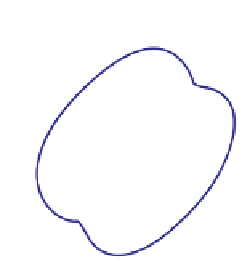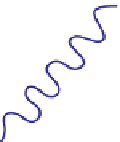Biology Reference
In-Depth Information
Angle
Fig. 14.14
The honey bee waggle dance provides information about both the distance
and direction of nectar sources. After returning to the hive, successful foragers dance in
a figure of eight pattern on the vertical comb. Distance to the nectar source is encoded
by length of the straight line part of the dance, during which the workers waggle from
side to side. The direction of the straight line part of the dance relative to the vertical
plane of the honeycomb shows the direction of the nectar source relative to the sun.
Photo © Kim Taylor/naturepl.com
release into the environment (Williams
et al
., 2007). These molecules are then taken up
by other bacterial cells where they have two consequences. Firstly, the uptake of
signalling molecules stimulates the production and release of a number of other
molecules, termed exoproducts. These exoproducts have a variety of uses that facilitate
bacterial growth and success, including: enzymes that break down proteins, polymers
to provide structure for growth, surfactants to facilitate movement and toxins to break
down host tissues. Secondly, the uptake of signalling molecules stimulates the
production of the signal molecule itself. This leads to positive feedback at high cell
densities (when the quorum is reached), which results in a marked increase in
production of both signal and exoproducts.
It has been argued that the process of quorum sensing represents signalling
between bacterial cells to coordinate the production of exoproducts. The idea here is
that the production of exoproducts is only worthwhile at high cell densities, where
they are likely to provide a significant benefit to the local cells. In contrast, at low
densities, exoproducts would disperse into the environment before they can benefit
cells, making their production relatively inefficient (Fig. 14.15). In the microbiology
literature it has long been assumed that quorum sensing would be favoured to do this,
because it would provide a benefit at the population level (e.g. Shapiro, 1998; Henke
& Bassler, 2004).
However, as explained in Chapter 1, natural selection does not work in this way.
Specifically, quorum sensing cells could be exploited by cells that avoided the cost of
producing the signal themselves, and just responded to the signals of others, or by cells
Quorum sensing
allows bacteria to
switch on certain
behaviours at
high population
densities























































